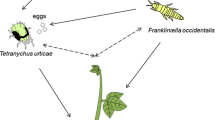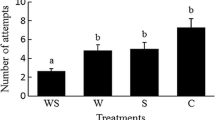Summary
A basic assumption usually made in measuring the functional response of a predator (predation rate) is that it depends on the density of the prey but not on the size, form, or small-scale spatial structure of the studied area. This assumption has been tested by experiments with the predatory mite Phytoseiulus persimilis and the spider mite Tetranychus urticae as prey.
In experiments carried out on arenas with different internal spatial structure the predators had a lower predation rate on those arenas with a higher degree of spatial heterogeneity. On arenas with no additional internal structure but of different shape the predation rate was highest on squares with a relatively short border. The differences in predation rate are explained by two effects. The borders influence the otherwise random movements of predator and prey in such a way that both stay slightly more often along the border. The shorter the total length of borders the higher is the probability of predator and prey meeting along a border; therefore predation rates on plain squares are higher than would be expected from completely random movements and distribution. In addition to this edge effect the arrangement of borders forming labyrinths results in a lower predation rate, probably by impeding searching movements. The encounter rate between predator and prey was much higher than the predation rate. Encounter rate and predation rate were not directly proportional.
It may be generally concluded that in predatory mites and probably in all other predators too, the functional response not only depends on the density of the prey but also on the size and the small-scale spatial structure of the experimental area or the habitat.
Similar content being viewed by others
References
Amano H, Chant DA (1977) Life history and reproduction of two species of predacious mites, Phytoseiulus persimilis Athias-Henriot and Amblyseius andersoni (Chant) (Acarina: Phytoseiidae). Can J Zool 55:1978–1983
Chant DA (1961) The effect of prey density on prey consumption and oviposition in adults of Typhlodromus (T.) occidentalis Nesbitt (Acarina: Phytoseiidae) in the laboratory. Can J Zool 39:311–315
Everson P (1979) The functional response of Phytoseiulus persimilis (Acarina: Phytoseiidae) to various densities of Tetranychus urticae (Acarina: Tetranychidae). Can Ent 111:7–10
Everson P (1980) The relative activity and functional response of Phytoseiulus persimilis (Acarina: Phytoseiidae) and Tetranychus urticae (Acarina: Tetranychidae): The effect of temperature. Can Ent 112:17–24
Fernando MHJP, Hassell MP (1980) Predator-prey responses in an acarine system. Res Popul Ecol 22:301–322
Fransz HG (1974) The functional response to prey density in an acarine system. Center for Agricultural Publishing and Documentation, Wageningen
Fujita K, Inoue T, Takafuji A (1979) Systems analysis of an acarine predator-prey system. I. Res Popul Ecol 21:105–119
Hassell MP (1978) The dynamics of arthropod predator-prey systems. Princeton University Press
Hassell MP (1980) Some consequences of habitat heterogeneity for population dynamics. Oikos 35:150–160
Hassell MP, Lawton JH, Beddington JR (1976) The components of arthropod predation. I. The prey death-rate. J Anim Ecol 45:135–164
Hassell MP, May RM (1974) Aggregation of predators and insect parasites and its effect on stability. J Anim Ecol 43:567–594
Holling CS (1959a) The components of predation as revealed by a study of small-mammal predation of the European pine saw-fly. Can Ent 91:293–320
Holling CS (1959b) Some characteristics of simple types of predation and parasitism. Can Ent 91:385–398
Holling CS (1966) The functional response of invertebrate predators to prey density. Mem Ent Soc Can 48:1–86
Huffaker CB (1958) Experimental studies on predation: Dispersion factors and predator-prey oscillations. Hilgardia 27:343–383
Kaiser H (1975) Populationsdynamik und Eigenschaften einzelner Individuen. Verhandl Ges Ökologie, Erlangen, 25–38
Kaiser H (1979a) The dynamics of populations as result of the properties of individual animals. Fortschr Zool 25:109–136
Kaiser H (1979b) Räumliche Heterogenität und Beutefang von Raubmilben. Verh Dtsch Zool Ges 1979, 254
Laing JE (1968) Life history and life table of Phytoseiulus persimilis Athias-Henriot. Acarologia 10:578–588
Laing JE, Osborn JAL (1974) The effect of prey density on the functional and numerical responses of three species of predatory mites. Entomophaga 19:267–277
Michaelis H (1978) Suchen Raubmilben die gleichen Stellen an Pflanzen auf wie ihre Beutetiere? Untersuchungen an Phytoseiulus persimilis Athias-Henriot (Acarina: Phytoseiidae) und Tetranychus urticae Koch (Acarina: Tetranychidae). Diplomarbiet Köln-Bayreuth, 1–108
Mori H (1969) The influence of prey density on the predation of Amblyseius longispinosus (Evans) (Acarina: Phytoseiidae). Proc 2nd Int Congr Acarology 1967:149–153
Mori H, Chant DA (1966a) The influence of prey density, relative humidity, and starvation on the predacious behaviour of Phytoseiulus persimilis Athias-Henriot (Acarina: Phytoseiidae). Can J Zool 44:483–491
Mori H, Chant DA (1966b) The influence of humidity on the activity of Phytoseiulus persimilis Athias-Henriot and its prey, Tetranychus urticae (CL Koch) (Acarina: Phytoseiidae, Tetranychidae). Can J Zool 44:863–871
Murdoch WW, Oaten A (1975) Predation and population stability. Adv Ecol Res 9:1–131
Ohnesorge B (1978) Der Einfluß der Besiedlungsdauer spinnmil-benverseuchter Bohnenblätter auf die räumliche Verteilung der Raubmilbe Phytoseiulus persimilis A.-H. (Acarina: Phytoseiidae). Z ang Ent 85:337–340
Ohnesorge B (1981) Populationsdynamiche Untersuchungen in einem Räuber-Beutetier-System: Phytoseiulus persimilis A.-H. (Acarina: Phytoseiidae) und Tetranychus urticae Koch; 1. Teil: Reproduktionswert, Verzehrwert und Verzehrpotential. Z ang Ent 91:25–49
Rabbinge R (1976) Biological control of fruit-tree red spider mite. Centre for Agricultural Publishing and Documentation, Wageningen
Sabelis MW (1981) Biological control of two-spotted spider mites using phytoseiid predators. Part I. Centre for Agricultural Publishing and Documentation, Wageningen
Schliesske J (1981) Vergleichende Untersuchungen an Amblyseius channabasavanni und der in der biologischen Schädlingsbe-kämpfung eingesetzten Phytoseiulus persimilis (Acari: Phytoseiidae). Mitt dtsch Ges allg angew Ent 3:118–121
Schmidt G (1976) Der Einfluß der von den Beutetieren hinterlassenen Spuren auf Suchverhalten und Sucherfolge von Phytoseiulus persimilis A-H. (Acarina: Phytoseiidae). Z ang Ent 82:216–218
Solomon ME (1949) The natural control of animal populations. J Anim Ecol 18:1–35
Takafuji A, Chant DA (1976) Comparative studies of two species of predacious phytoseiid mites (Acarina: Phytoseiidae), with special reference to their responses to the density of their prey. Res Popul Ecol 17:255–310
Voit E (1976) Räumliche Verteilung und Häufigkeit des Zusammentreffens von Spinnmilben und Raubmilben (Tetranychus urticae und Phytoseiulus riegeli, Acarina). Diplomarbeit Köln, 1–91
Author information
Authors and Affiliations
Additional information
Supported by a grant from the Deutsche Forschungsgemeinschaft
Rights and permissions
About this article
Cite this article
Kaiser, H. Small scale spatial heterogeneity influences predation success in an unexpected way: Model experiments on the functional response of predatory mites (Acarina). Oecologia 56, 249–256 (1983). https://doi.org/10.1007/BF00379698
Received:
Issue Date:
DOI: https://doi.org/10.1007/BF00379698




